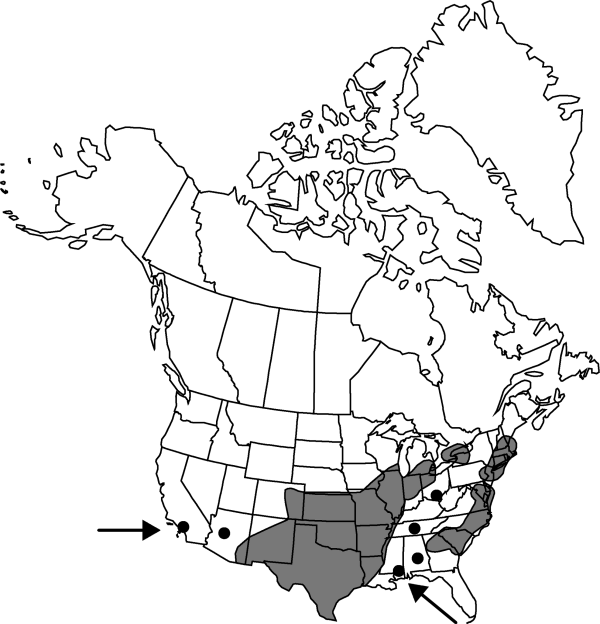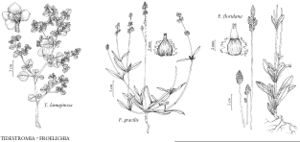Froelichia gracilis
in A. P. de Candolle and A. L. P. P. de Candolle, Prodr. 13(2): 420. 1849.
Plants annual or short-lived perennial; taproots narrow, enlarged when perennial, semiwoody. Stems several (rarely 1), erect or ascending, sometimes procumbent, usually much-branched from base, slender, 1–5(–10) dm, densely or sparsely villous-tomentose with grayish white hairs. Leaves predominant on proximal 1/3 of plant, often basal, sessile; blade linear to lanceolate or lance-elliptic, largest leaves 1.6–9(–13.5) × 0.2–0.9(–1.2) cm, base acuminate or attenuate, apex acute to acuminate, canescent or sericeous adaxially, sericeous-tomentose with white or gray hairs abaxially. Spikes sparsely branched, flowers arranged in 3-ranked spiral; bracteoles stramineous or blackish, glabrous. Flowers 2.4–3.8 mm; perianth lobes oblong-linear, apex acute or acutish, pubescence grayish; filament lobes stramineous or blackish, blunt. Utricles 2.5–5 × 2.7–4 mm, apex slightly oblique, with irregularly and deeply cut (“spiny”) lateral wings, both surfaces of perianth with distinct spines or tubercles. 2n = 54.
Phenology: Flowering summer in north, year-round in extreme south.
Habitat: Open plains, rocky hillsides, roadsides, waste ground, railroad ballast
Distribution

Ont., Ala., Ariz., Ark., Calif., Colo., Conn., Ga., Ill., Ind., Iowa, Kans., Ky., La., Md., Mass., Mich., Miss., Mo., Nebr., N.H., N.J., N.Mex., N.Y., N.C., Ohio, Okla., Pa., S.C., Tenn., Tex., Va., W.Va., Wis., Mexico (Chihuahua, Coahuila, Nuevo León, Tamaulipas), introduced in Europe, Asia (Japan).
Discussion
The current range of Froelichia gracilis is due in large part to its introduction via railroads during the past 100 years, and the majority of records for the species east of the Mississippi River occur on or near railroads. S. F. Blake (1956) discussed this eastern spread of the species. Froelichia gracilis is considered a minor invasive weed in the Northeast; its adaptation to open sandy or gravely soils will restrict its spread to open sites with poor soil.
In regions where their ranges overlap, Froelichia gracilis may hybridize with F. floridana. Plants with intermediate form from Texas and the Midwest have been noted. Suspected hybrids appear closest in habit to F. gracilis and will generally key to that species. Floral structure will be intermediate and variable; the branching will be typically less than in F. gracilis and present distal to the base.
Selected References
None.
